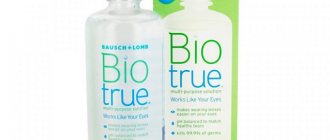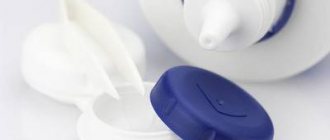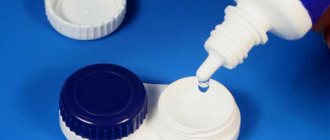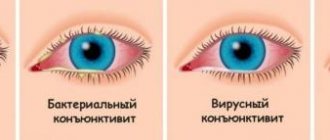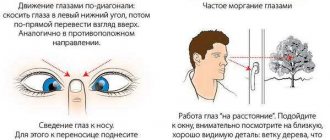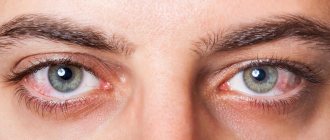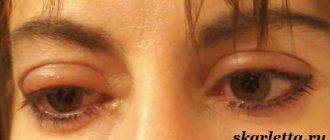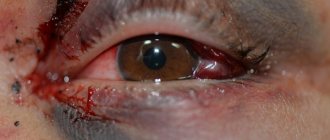How to properly wash lenses
The lens rinsing solution contains antiseptic components that eliminate harmful germs and bacteria.
The use of other processing agents is not recommended. This can cause an allergic reaction, conjunctivitis, and cause blurred vision. How to rinse lenses with a solution? It takes a minimum of time to process lenses for planned replacement
The main thing is to maintain sterility and caution. The procedure for cleansing personal items is carried out in the evening hours, that is, before bedtime, after removing them from the eyes.
Disinfectant is poured into each compartment of the lens container.
Before starting to process the lenses, wash your hands with antibacterial soap that does not contain fragrances, then wipe them with a waffle towel or a thick cloth.
After removal, the lens is placed on the palm of your hand, 2-3 drops of solution are dripped onto its surface with your free hand and wiped on both sides with the little finger. Then the product is dripped inside the lens again and washed thoroughly. After processing, it is placed in a container overnight. The same manipulations are carried out with the second lens.
What means can be used to treat “invisible glasses” if the solution is not at hand? Most ophthalmologists give a clear answer to this question: you cannot use anything other than a disinfectant solution. Otherwise, the risk of developing eye diseases increases.
However, not all experts are so categorical. In extreme cases, to avoid drying out the lenses, it is allowed to use:
- sterile eye drops;
- sodium chloride (0.9%);
- saline solution
Is it possible to wash lenses with tap water? No, since tap liquid contains a large number of pathogenic organisms. Getting them inside the eye causes irritation, redness and conjunctivitis.
Is it possible to wash lenses with saline solution? Yes, saline solution (sodium chloride) is included in the list of approved lens treatments. However, the drug can be used only in extreme cases, no more than 1 time. The saline solution does not contain antiseptic components, therefore it is not able to disinfect the surface of the lens.
After using sodium chloride as a cleaner, lenses should be treated as quickly as possible with a sterile disinfectant.
Eye drops are also used to maintain the shape of "invisible glasses". You need to use an unopened package of the medicine, pour the drops into the container and place it inside the lens overnight. If a container is not at hand, you can use sterile, tightly sealed jars.
Existing varieties
Thanks to the rapid development of medical technologies, modern optics offer a wide range of lenses for the eyes. Depending on the duration of wearing they are divided into:
- Daytime ones, which must be removed before bedtime.
- Flexible, in which you can spend no more than two nights.
- Extended wear, designed for 24/7 use.
- Continuous use, which can not be removed for 30 days.
In addition, there is another classification based on replacement timing. According to it, there are the following types of eye lenses:
- One-day ones - put on in the morning and thrown into a bucket in the evening.
- Traditional, designed for six or twelve months.
- Planned replacement, used no longer than thirty days.
Depending on their purpose, therapeutic, cosmetic and optical lenses are distinguished. The first ones are used during the treatment process, the second ones temporarily change the shade of the iris, and the third ones correct vision.
Depending on the material used to make lenses, they can be divided into:
- Hard, made of silicone. They keep their shape perfectly for a long time, have a long service life and are resistant to mechanical damage. Caring for eye lenses belonging to this category is quite simple. It comes down to regular washing with cleaning solutions.
- Soft. These products are extremely popular among people all over the world. In turn, they are divided into silicone hydrogel and hydrogel. The first ones allow oxygen to pass through perfectly and are completely safe for the human eye. They can be worn from two weeks to one month. The latter have a soft and flexible structure. They are intended for daytime wear. Sleeping in such lenses can cause corneal hypoxia.
Rules for storing lenses
To properly store your contact lenses in the case, you must always keep it closed. You need to check every time that the lid is screwed on properly.
This is especially important if the container is being moved from place to place, as a poorly sealed container can cause liquid to spill, causing the lenses to dry out and deteriorate. There should only be one lens per compartment of the container, regardless of what type of lens is used.
Only one lens should be placed in one compartment of the container, regardless of what type of lens is used.
It is important to pour a sufficient amount of solution into the containers. It should be half filled, and the lens should be completely immersed in liquid
Most manufacturers produce containers that have special markings for the solution.
We also recommend reading how to put on lenses.
Vascular network in the eyes - what to do?
To store and wet contact lenses, do not use running water, saline solution or already used solution. Such liquids are not sterile, so they can easily introduce bacteria into the eyes.
Each time a person uses contact lenses, they should refill with fresh solution. Do not add clean solution to dirty solution.
The length of time a lens can be stored in a container depends on its cleanliness, the shelf life of the liquid, and the lenses themselves. If contact lenses are rarely used, then once every 2-3 days it is necessary to check the quality of the liquid in the container.
If it becomes a different color or smells different, then you can no longer use the lenses that were in it, as this can cause various eye diseases.
How to care
To ensure that lenses last a long time, they should be stored in a tightly closed container, into which a special solution has been previously poured. Each time you use the case, you must check how tightly the lid is attached. This is important if it is often carried from place to place. If the cap is not screwed on tightly, liquid may spill out, causing the lenses to dry out and become unusable. The cases should be placed on a stable surface to prevent the solution from spilling.
It is worth considering that one compartment is designed for only one lens. The solution should fill approximately half of the compartment. It should completely cover the product on all sides. Most manufacturers make a special mark inside the container to guide you on exactly how much liquid to pour.
Lenses should be removed with great care. This can be done using your fingertips or special plastic tweezers with rounded ends. You should not remove such optics with your fingernails, as you can easily damage the polymer product.
Only a specific solution can be used to store lens products. In some cases, saline solution can be used. You should not pour ordinary water into the container, since a perfectly smooth surface quickly becomes rough.
The liquid in the case must be changed regularly, but you cannot add a new portion to the remainder. If the liquid in the case begins to smell bad, the lens products should be thrown away immediately.
Product Description
Multifunctional sterile solution Opti Free is a clear, colorless liquid without a specific odor. It is available in plastic bottles of 60, 120, 240 or 355 milliliters. The bottle is equipped with a convenient dropper spout. The solution contains:
- Polydronium chloride;
- Aminomethylpropanol;
- Myristamidopropyl dimethylamine;
- Poloxamine;
- Citrate;
- Sorbitol;
- Boric acid;
- Disodium EDTA;
- Sodium chloride.
This solution provides a high degree of disinfection. It is effective against bacterial and fungal infections, as well as cysts. An analogue can be considered a ReNu solution.
There are the following types of Opti Free multifunctional solution:
Opti Free Replenish. Provides lens hydration for 14 hours, which helps maintain eye health. Provides excellent clarity of vision and facilitates the process of putting on and removing lenses. Provides a high level of protection against infections, including fungal ones;
Opti Free Replenish
Opti Free Express. Can be used for both daily and occasional use. Cleans lenses, moisturizes and quickly removes fat and protein deposits. Can be used not only as a lens care product, but also as moisturizing eye drops. They relieve fatigue and redness, for example after prolonged work at the computer;
Opti-Free Express
Opti Free Pure Moist. This is the most progressive product in this line. It not only effectively disinfects and cleans, but also prevents particles of dirt and dust from getting onto the lens. It helps the lenses adapt to the tissues of the eyes, ensuring wearing comfort. Its use allows you to do without enzymatic cleaners. Find out which is better, one-day or two-week lenses here.
Opti Free PureMoist
For complete disinfection, the lenses are placed in a container for at least 6 hours.
How to choose lenses for your eyes?
To avoid problems, you should consult a professional ophthalmologist before visiting the optician. In addition to a standard vision test, he will conduct additional examinations to identify all existing pathologies and select the most effective lenses. In the selection process, the specialist must take into account:
- Intraocular pressure.
- Diopter size.
Before choosing lenses for your eyes, your ophthalmologist should perform a corneal curvature analysis and peripheral vision assessment. To ensure that wearing them does not cause discomfort, you definitely need to decide on the size and material from which they are made. You should be offered a first trial pair before purchasing. It is worn for only fifteen minutes, after which a specialist assesses the condition of your eyes and decides whether they are suitable for you or not.
An ophthalmologist will tell you how to use the lenses. He will show you how to take them off and put them on. In addition, there are several simple rules that everyone who wears lenses must follow. You only need to work with them with clean, dry hands with short-cut nails. It is recommended to wear them in a well-lit room. It is better to do this over a table covered with a clean napkin. You need to carry out all manipulations on the left with your left hand, and with your right hand on the right.
Before putting on contact lenses, they are placed on the pad of the finger and carefully inspected. Slightly turned outward edges indicate that this is the wrong side. They should be put on very carefully. This is usually done using the index and middle fingers. Once the lens is where it is needed, it is advisable to close your eyes and rotate them several times.
IMPORTANT TO REMEMBER!
- Wear contact lenses before applying makeup.
- Remove lenses before removing makeup.
- Do not let others try on your lenses.
- Do not expose the lenses to aerosol drops or splashes of foreign liquid.
- If you have a cold, it is not recommended to wear contact lenses.
- Do not use contact lenses for viral diseases until complete recovery. The pair of lenses you were using when the infection occurred should be thrown away. After recovery, you need to put on a new pair and purchase a new container.
- Wearing contact lenses is not recommended for swimming in open water without special glasses or a mask, or use daily contact lenses.
- If the lenses are damaged at the slightest level, do not use them under any circumstances.
- Using lenses longer than the allotted time is harmful to health! Follow the wearing regimen recommended by your doctor and written on the contact lens packaging.
DON'T FORGET TO PASS THE SCHEDULED INSPECTION!
Only a doctor can notice possible deviations from the norm in a timely manner, answer any questions that arise and give recommendations.
If your vision in lenses has become worse, under no circumstances decide for yourself to switch to lenses with larger diopters. Check with your doctor first.
THIS IS A GUARANTEE OF THE HEALTH OF YOUR EYES!
Liquid for lenses at home
If you don't have a solution designed for storing contact lenses, try making lens liquid at home.
In order not to spoil the lenses, you need to imitate the special solution that is used for storing and washing contact lenses and is sold at the pharmacy. This solution is multi-purpose:
- it retains the shape of the lenses (salts and acids in the composition are responsible for this);
- disinfects;
- cleanses of protein and fatty deposits, removes contaminants of other nature (surfactants are used for this purpose);
- Conditions, lubricates and moisturizes (hyaluronic acid).
This cannot be achieved with home remedies. Let's consider what can replace the factory solution, at least as a temporary alternative.
Saline solution for lenses
Saline solution or sodium chloride 0.9% is the most suitable remedy.
The one packaged in ampoules is better suited. It is sterile and its chemical composition is close to human tear fluid. About 15-20 years ago, SCLs were sold in glass bottles filled with an isotonic saline solution. Holding a lens in it will preserve its original characteristics, but will not disinfect it.
Modern hydrogel lenses should not be stored in saline solution for more than 12 hours. Before putting them on, they should be in the multifunctional solution for at least 3-4 hours.
Salty water
If you don’t have saline solution at home, you can make it yourself, because it essentially consists of distilled water and table salt.
How to make lens solution:
- take 9 g of salt per 1 liter of water (or 100 ml of water and salt on the tip of a knife);
- boil water for 20 minutes, gradually adding salt;
- cool the resulting solution to a slightly warm temperature (during this time the sediment will settle);
- pour the solution into a suitable container.
Attention, do not overdo it with salt. Salt should not be more than the specified amount
It must be clean, without impurities. "Extra" will do.
Boil all containers and spoons.
Lenses should not be left in saline solution for more than 12 hours. Silicone hydrogel models may swell in it. Before use, soak lenses in multi-use solution. To reduce possible eye irritation, use Taurine (eye drops) for several days.
Water with hydrogen peroxide
This antiseptic can be found in almost every home.
As the main component, peroxide is included in the composition of peroxide solutions in long-term wear CL cleaning systems. It removes viruses, bacteria, protein and other deposits. For preparation use 3% solution. Purification systems also necessarily use a peroxide neutralizer - plates containing platinum or enzyme tablets. It is needed to deactivate hydrogen peroxide after cleaning lenses with a peroxide solution.
To avoid eye burns, do not put on lenses immediately after they are in a hydrogen peroxide solution. To neutralize it, rinse the lenses with sodium chloride solution and then soak in a multifunctional solution for 3-4 hours.
Nasal drops
In pharmacies there are nasal drops that are analogues of saline solution: Aquarinosol, AquaMaster, Salin. They consist of distilled water and salt, designed to rinse the nose and eliminate dryness of its mucous membrane.
These drops can serve as a temporary replacement for a special solution for lenses, and they are also sterile and conveniently packaged.
Eye drops
As a temporary replacement for a special solution for lenses, it is best to use drops designed to moisturize the eyes while wearing contact lenses.
The lenses will be kept in a liquid with the correct ratio of water and salt, which will help maintain their shape and prevent them from drying out. In addition, these eye drops often contain hyaluronic acid, which will provide the necessary conditioning. However, this will not provide disinfection and cleaning.
And, of course, think about where you can put the lenses.
It’s great if you have 2 test containers on hand. They are sterile: you just need to open the caps, pour the solution into them, put the lenses in and close them. Don't forget to label where the left lens is and where the right one is.
This is important if the lenses have different diopters. In addition, it is believed that each eye gets used to its “own” lens. As a last resort, glassware will also work: jars and glasses.
Just be sure to boil them and, after putting CL in them, cover them with a sheet of paper to prevent dust from falling.
Why is this very solution needed?
It performs the following functions:
- Storage. You can’t just store lenses like that: put them on the surface of cabinets, tables and various shelves. Each one should have its own case in which you can store them without the possibility of hastening their disposal date.
- Disinfection. Well, here, it would seem, there’s nothing worth saying. But we must remember that this concerns your body, and in particular vision - the most important human ability. If storage standards are not observed, and this may include the wrong choice of solution for lenses, and a neglectful attitude towards preparing this very solution at home, without much effort you can introduce an infection into the eye, expose the eye to inflammation and other negative consequences. Then a trip to the doctor will be necessary. So this is perhaps one of the most important points.
- Cleansing. During a difficult and eventful day, it is simply necessary to clean contact lenses from dust, debris, and protein deposits from the eye itself, which the solution does an excellent job of.
- Well, the last item on this list is hydration. It is very important to moisturize not only the eye while wearing contact lenses, but also the lenses themselves. This way they will last you much longer.
Disinfection
Disinfection is a periodic procedure that ensures comfortable wearing and performs a protective function. As a rule, it is carried out by applying special compounds: chlorhexidine, polyquad, benzalkonium chloride, and so on. A peroxide system is often used to sterilize and effectively remove deposits and contaminants. Disinfection is relevant for lenses that have a service life of more than one month. Frequency of disinfection: once every one to two weeks
.
The main active ingredient in disinfectant solutions is a three percent solution of hydrogen peroxide, which effectively fights a wide range of bacteria and microorganisms.
How to make an analogue of lens products at home
If, after removing your contact lenses, you do not have the necessary cleaning product at hand, you need an alternative in the form of an analogue.
It is possible to foresee such cases, and it is possible to replace the solution at home.
If you completely neglect proper storage, then later it will be impossible to put dried products on your eyes.
To prepare the solution you will need:
- a sterile container or a suitable replacement;
- filtered water;
- sanitized spoon;
- table salt.
Solution preparation and storage:
Take a sterile container with a tight-fitting lid. To be sure of its suitability, you can boil the container for a few minutes or rinse it with antiseptic agents.
Having boiled and cooled the required amount of water, add the certified salt in small portions and stir thoroughly (0.5 teaspoon per 200 ml of water). Once you place your lenses in a container of liquid, it is important to close it tightly.
If the lenses have a rigid structure, then for care you can use ordinary medical alcohol or boiled water. Silicone hydrogel lens models will not tolerate such manipulations.
Do not use boiling water as it will damage any type of lens.
Reference! It is not recommended to use such homemade compositions if you have eye diseases or allergies or hypersensitivity to their individual components.
If, nevertheless, circumstances arise that make it necessary to make the solution yourself, then it is necessary to observe whether any unpleasant sensations appear while wearing them after using such a product.
How to care for contact lenses
The lenses provide comfort. They just require careful handling. The key to durability is proper use. Learning to insert and carefully remove is half the battle. The products do not deteriorate on the organs of vision while wearing. They become unusable, transparency is lost, and focus changes for other reasons.
Do you know how to care for contact lenses?
Not really
Basic Rules:
- hand hygiene It is important to wash with soap and dry before work. Drops of water, debris, microbes will cause clouding, microscopic scratches, and eye problems;
- the use of a special liquid. It is strictly forbidden to fill or rinse with ordinary water, such as removable dentures. In rare cases, saline solution or liquid eye medications are used for a short time;
- sequence of actions. When using optics with different diopters, we recommend taking double containers. Or, to avoid confusion, always take off and put on in a certain sequence;
- storage in designated containers. The use of a special container should not be neglected. It has a suitable size, reduces the consumption of solutions, is hermetically sealed, and prevents moisture evaporation and drying out.
We recommend paying special attention to cleaning procedures. Plaque accumulates on the surface. Soaking in a special liquid inhibits its formation. Just does not cancel the implementation of full hygiene measures.
You need to care for contact lenses daily: clean them, monitor hand hygiene, use special liquids, containers with tweezers. Periodic disinfection with peroxide systems is required.
Daily cleaning
Do not remove lenses, throw them into a container with liquid, and leave them until next time. We recommend that you maintain your optics daily. Simple manipulations require no more than 1-2 minutes in the evening.
How to properly care for:
- Wash your hands and wipe dry.
- Place the lens on your palm with the concave side facing up.
- Drizzle liquid on top. It is convenient to use universal cleaning/storage systems.
- Use your finger to gently wipe the surface, turn over, repeat.
- Place in a jar and fill with a fresh portion of the solution.
You cannot use regular detergents or cosmetics for your face or body for everyday cleaning.
Enzymatic purification
Silicone hydrogel optics have a porous structure. Microscopic holes gradually become clogged with dust, dirt, and mucous secretions. Gradually, microbes multiply, causing irritation of the mucous membranes and the occurrence of ophthalmological diseases. Enzymatic cleaning will help prevent problems. It is carried out with special tablets.
Rules for storing contact lenses
Step-by-step instruction:
- Pour your everyday product into clean containers.
- Add tablets according to instructions. Dissolve.
- Immerse the lenses. Leave for contact, time depends on the composition. It is advisable to read the manufacturer's recommendations.
- Take out and wash with everyday cleanser. Place in a clean container and fill with fresh solution.
It is important not to exceed the operating time of the tablets specified by the manufacturer in the instructions. Do not leave it uncontrolled all night. This risks damaging the material.
Disinfection
Disinfection is required for long-term lenses. If you replace it once a month, it is not needed. The procedure is carried out every 2 weeks. The pharmacy sells peroxide compounds. They are poured into a container. The exposure time is indicated in the instructions.
You may hear a recommendation to replace peroxide systems with regular hydrogen peroxide at a concentration of 3%. This cannot be done!
In what container should I store it?
If the client will use the same pair of products for a long time, he should familiarize himself with the rules for storing liquids for them.
If the packaging of the vision correction device has not yet been unsealed, the shelf life may last as long as indicated in the corresponding column.
How to use and store products, and what to do if there is no solution for lenses:
- Purchasing a special container is a prerequisite for storing this kind of material.
- The liquid is used only once to clean the surface of the lenses; it is not recommended to do this again.
- It is better to regularly inspect the container with a magnifying glass for contamination.
- It is not recommended to mix the remains of the old solution and the new one; each time you should thoroughly rinse the container. If you have completely run out of the branded solution, you can make lens liquid at home (more on this below).
- Heat treatment of the container itself once a week is also necessary.
- The cleanliness of products that are removed from the solution is ensured by washing your hands well and using tweezers as a holder.
- Products should be completely immersed in the solution; some manufacturers even have special marks for correct pouring of liquid.
To keep your vision at the desired level and prevent it from falling, you should follow these simple rules.
Having found a replacement solution, you need to decide what can be used instead of the container. If you don’t have one, ordinary glassware, such as a shot glass or any other small glass container, will do. Before placing an optical product in it, be sure to boil the future container.
- Water. Both tap and boiled water cannot be used for temporary storage of optical instruments, since it contains a large number of bacteria.
- Saliva. The opinion that you can wet your lenses with your own saliva at night is wrong; there are also plenty of microbes in it.
- The absence of any liquid will lead to the lenses drying out completely and making them impossible to use further.
How to wash your lens container
Such a container should be washed every three days, always with boiled water. Wash the case on both sides, and then be sure to rinse with an isotonic solution. Due attention is paid to various corners; it is in them that various debris accumulates.
After washing and rinsing the container, it should be left to dry for 15 minutes at room temperature. Drying is very important, since residual liquid is an ideal environment for the subsequent proliferation of microbes.
If the case has been in use for a long time and looks quite dirty, it is recommended to replace it with a new one without regret.
Main varieties and how much they cost
Despite the simplicity of the device, you can find several designs of containers for CL on sale that successfully cope with basic and additional tasks. Depending on your lifestyle, activity, aesthetic and functional preferences, you can choose the most optimal copy.
Classic horizontal
This is the simplest design of containers that can be found among most CL owners.
Why are these models valued?
- available in any pharmacy;
- have a very affordable price - the price starts from 50 rubles;
- easy to maintain and use.
But this type of case has one significant drawback. The lenses are stationary there, so it may take about 8 hours to completely disinfect and clean the optics.
Road
Travel containers for KL will be appreciated by supporters of an active lifestyle and lovers of travel. Such sets will be a real boon for workers who are forced to frequently travel on business.
The standard travel kit includes the following items:
- case with mirror;
- container for lenses;
- tweezers;
- bottle for solution.
The cost of sets with tweezers may vary depending on the type of design, the quality of the base raw materials, and design. But they cannot be called expensive - the price of a case with all its contents starts at 150 rubles.
The advantages of travel kits are obvious:
- compactness;
- mobility;
- ease of use.
Since such devices have to be used infrequently, you can count on a long service life, but subject to proper care.
Among the shortcomings, one can note the limited functionality of the sets. Compactness does not allow the device to incorporate all the variety of functions available for modern models.
Vertical
The shape of such containers resembles a glass or a barrel and allows you to immerse the optics not in a horizontal, but in a vertical position. How do you put lenses in a vertical container? A special holder is responsible for the process of immersing the optics, which does not allow the product to touch the walls and bottom of the container.
On sale you can find containers with rotating stacking for hard and soft lenses. With its help, the holder rotates around its axis, creating a vortex flow that maximally cleans the surface of the CL from contaminants.
The price of such a device in a pharmacy is 130-150 rubles.
Advantages of the models:
- suitable for cleaning with conventional and peroxide solutions;
- quickly and efficiently remove dirt and protein deposits;
- all cleaning products settle to the bottom of the container and do not come into contact with the optics;
- CLs do not touch the container, which reduces the risk of mechanical damage.
Some users note that vertical models require more disinfectant solution due to the larger reservoir capacity.
Improved
Improved cases for contact lenses are part of the line of antibacterial containers. The material from which containers of this type are made is enriched with inorganic silver ions. The metal is known for its disinfecting properties, which makes it possible to use it to disinfect the surface of CLs.
Advantages of innovative containers with silver ions:
- keeps lenses clean;
- maintains the safe chemical composition of the multifunctional solution;
- prevents the spread of microbes and the formation of deposits on the walls;
- has a long service life - up to 6 months.
Among the disadvantages, we can mention the higher cost (about 200 rubles), but it remains affordable for most buyers. Such cases are produced in a classic design, and cannot boast of a wide variety of shapes and designs.
RULES FOR USE OF CONTACT LENSES
INSTALLING LENSES
- Wash your hands thoroughly and dry your hands with a lint-free towel.
- To avoid mixing up lenses, always put on the lens for the right eye first.
- Remove the right lens from the container
- Place the lens on the pad of your index finger
- Check that the lens is positioned correctly.
- With the other finger of the hand you are putting on the lens, pull down the lower eyelid of your right eye and look up.
- Hold your upper eyelid with your other hand so as not to blink.
- Touch your finger with the lens to your eye, pressing it lightly.
- Remove your finger from your eye and slowly look down and blink.
- Slowly release your lower eyelid and close your eyes briefly
- Look straight ahead to see if your vision has improved.
- Repeat the same with the left lens.
REMOVING LENSES
- Wash your hands thoroughly and dry your hands with a lint-free towel.
- To avoid mixing up the lenses, the lens for the right eye is always removed first.
- Pull back the lower eyelid of your right eye and look up.
- Place the pad of your index finger on the bottom edge of the lens.
- Slide the lens down
- Gently grasp the lens between your thumb and forefinger and remove it from your eye.
- Repeat the same with the left lens.
ADAPTATION TO LENSES
- On the first day, the duration of wearing lenses is no more than 3 hours.
- In subsequent days, increase the duration of wearing by 1 hour.
- The maximum duration of wearing is individual - depending on the type of lenses and your sensations (individual tolerance).
- If after prolonged wear you feel discomfort, dryness or your eyes begin to turn red, use moisturizing drops or tear substitutes (which your ophthalmologist will recommend) or reduce the time you wear the lenses.
CARE OF CONTACT LENSES
- Every time you remove your lenses, be sure to clean, rinse, and disinfect them.
- All lenses (except disposable lenses) are subject to mechanical cleaning.
MECHANICAL CLEANING OF THE LENS
- Place the lens on your palm.
- Apply a few drops to the lens.
- Use your index finger to gently rub the surface of the lens.
- rinse the lens with solution
- place the lens in a container with fresh solution
ATTENTION!
- DO NOT USE THE SAME SOLUTION TWICE.
- DO NOT PUT LENSES IN YOUR MOUTH OR USE SALIVA TO CLEAN.
- BE SURE TO CARRY OUT MECHANICAL CLEANING, AS THIS WILL REMOVE 90% OF ALL SURFACE CONTAMINATION.
- THE CONTAINER MUST BE REPLACED EVERY 3 MONTHS AND WHEN YOU PURCHASE NEW LENSES.
Care for night lenses
Night (or orthokeratology) lenses are used during sleep. OK lenses are rigid, gas-tight products that allow you to correct the shape of the cornea and correct vision for one to two days. The effect of using such products is cumulative: after the first use, vision can be restored by 75%, after one week you can look at the world without any corrective agents. The service life of such products is 1-1.5 years.
OK lenses are selected together with an ophthalmologist based on the results of a thorough diagnosis of the visual system.
Products are cleaned after removal. There are solutions (for example, Boston Advance) that are designed specifically for daily treatment of OK lenses. Products can also be cleaned using peroxide systems (which, by the way, do not replace Boston Advance cleaning) once every 7 days.
OK lenses are processed in the following way:
- the lens is removed from the eyes using a suction cup and placed in the palm of your hand;
- 2-3 drops of disinfectant are applied to its surface;
- The product is wiped from all sides for a minute with your fingertips, without making much effort. Excessive friction can damage the material;
- the lens is rinsed with warm boiled water and then returned to the container filled with liquid;
- The container itself and the lid should be washed with soap without aromatic fragrances, carefully treating the threads with a toothbrush.
OK lenses should not be worn during the period of relapse of infectious diseases accompanied by elevated temperature: this can lead to complications. Such products should not be dropped or touched with your fingernails to avoid scratches and cracks.
Other necessary means
These are salt solutions “Lycotine Universal” or “Lycotine Comfort”. They are used for storage and washing, as well as for processing the optical device using high temperature or ultraviolet light. Sometimes they are used together with effervescent soluble tablets or other means for disinfecting and cleaning lenses. You cannot use only saline solutions in daily care. Proper lens care can be done using cleaning devices - they disinfect with ultrasonic waves. First, the lens is treated with a multifunctional solution and only then placed in this device.
Speaking about lens care products, it is worth mentioning enzymatic cleaners. These are the same tablets that help remove excess protein deposits, dirt, dust and mucus from the surface of the optical device. Effervescent products easily dissolve in any cleaner and mix with it until they have a homogeneous structure. The lenses are dipped in them for 15 minutes, after which disinfectants are used.
Why do lenses need specialized care?
Eye health directly depends on the quality of care for the contact lenses you use. If instructions are violated during operation or daily care is performed incorrectly, this can lead to negative consequences and the development of eye problems. Therefore, it is necessary to effectively and promptly care for your lenses.
Application of saline solution
You can satisfy the buyer’s wishes by knowing some of the nuances of choice:
- You need to choose a solution for its intended purpose for every day or a universal one, which is more convenient. In terms of caring for daily products, you do not need much time, since they must be changed constantly.
- But multifunctional options must be placed in a special solution before going to bed, which will get rid of bacteria, germs, protein deposits, and dust.
- The label and description of the composition of the liquid should be studied in advance before purchasing, since, for example, peroxide products have very serious contraindications.
- Ordinary water is not suitable for liquid where to put lenses if there is no solution, since it already contains a large number of bacteria, which, in turn, can lead to the formation of mold. This also includes boiled and distilled water.
- It is strictly forbidden to wipe the surface of the lens with saliva, for the same reason as with water.
- If you completely refuse to use liquid, this will lead to the surface drying out and damage not only the material, but also your vision.
The condition and quality of the lens is affected by both exogenous and endogenous factors. Dust and dirt get onto it from the outside, and protein secretions from the eye settle on the inside. Sediments of different types are deposited on both surfaces, which makes the surface of the material uneven. Wearing such a correction product entails discomfort and irritation when worn. As a result of improper care, a person will feel pain, pain and burning in the eyes. Microtraumas may appear on the cornea of the eye.
Special products have a cleansing and disinfecting effect. They remove all protein deposits, rinse and moisturize. Factory solutions are the most suitable means for storing lenses.
Multifunctional solutions allow you to perform all necessary care procedures in one step, since they can act as a means of cleaning, lubricating, moisturizing and storing lenses.
If you are unsure whether a particular solution is suitable for your lens type, you should consult your ophthalmologist.
- Using saline solution. This option is most optimal if you don’t have a special functional liquid at hand. The container or container in which you intend to store your devices must be thoroughly disinfected. To do this, the container is washed and boiled for 10 minutes. Then saline solution is poured into it and the lenses are immersed. Note that they must be completely covered with liquid. The field of this container is closed.
- Using eye drops. Placing the lenses in eye drops will help prevent them from drying out. However, since this product does not have disinfectant functions, they must be put on only after disinfection in a special liquid.
- Distilled water. If you don't have any saline solution or eye drops on hand, at worst, you can put the lenses in distilled water. However, remember, you can wear them only after disinfection in a purchased multifunctional solution.
- Brine. This liquid is similar in composition to saline solution, but its preparation requires precise proportions. In addition, it is absolutely forbidden to put on lenses after storing them in this homemade product without subsequent disinfection.
We figured out how to replace contact lens solution. All that remains is to find out how to properly prepare salt water. First of all, you need to prepare the container. To do this, you should not only wash it thoroughly with detergents, but also boil it. This procedure should be carried out with all tools that will be used in the process of preparing the solution.
Pour 1 liter of filtered water into the prepared container. After this, you should add salt in small amounts, step by step. Each new portion of this component is introduced only after the previous one has dissolved.
The finished solution should be cooled and then poured into a container. It is recommended to clean the lenses mechanically and place them in salt water. After this, the container must be well closed. Be careful when putting on lenses after using salt water. If the products are deformed or discomfort is felt, it is recommended to remove the products.
How to clean contact lenses every day
Even lenses designed to last a long time should be removed and cleaned daily. For washing and storage, use a special solution recommended by an ophthalmologist, a plastic container with two containers and rubberized tweezers.
Mechanical cleaning
Daily mechanical cleaning is a fairly simple process. The main thing is not to drop the device and not to put too much pressure on it to avoid ruptures. So, how to rinse lenses with a solution:
- hands with soap and dry with a napkin or lint-free towel (soap should be chosen without essential oils or fragrances: bactericidal is best);
- process the container and tweezers;
- pour a little disinfectant solution into your cupped palm and place the lens there;
- gently and gently wipe the correction device with your finger;
- holding it with tweezers, rinse it in the solution and place it in a container;
- Close the lid tightly and leave it like that for several hours;
- repeat for the other lens.
During the cleaning process, there is no need to spare the solution: harmful substances remain in the liquid used once.
Universal means
Daily care became less burdensome when multi-purpose solutions labeled No Rub appeared on the market. The substances contained in these products take care of cleaning and disinfecting contact lenses. They are only suitable for those who buy a new pair every 2 weeks. Correction devices that are designed for long-term wear require more careful care, so mechanical cleaning should not be abandoned.
How to clean lenses with No Rub? Care comes down to daily change of liquid in containers. Disinfectants in solution (polyhexanide, poloxamine, biguanides) destroy dirt without additional cleansing and rinsing.
Monthly deep lens cleaning tablets
For correction devices whose service life exceeds 1.5 months, deep treatment is required using enzyme tablets for cleaning lenses or enzyme solutions. They are able to remove calcium and protein deposits that a regular all-purpose solution or mechanical treatment cannot handle.
Learn how to starch a shirt to bring it back to its original appearance.
Rodents often become unwanted neighbors in private homes. You can read how to remove mice here.
How to clean lenses with tablets:
- wash and dry your hands, prepare tweezers, container and tablets;
- in a filled container, dissolve one tablet in each container (they will behave like pop - you don’t need to stir anything, just wait);
- place correction devices in a container, close and leave for the time specified in the instructions (usually from 15 minutes to 6 hours);
- then you should rinse the container and lenses with a multifunctional solution for daily care, refill the container and leave for another couple of hours;
- only then are they ready for use.
Such deep cleaning should be performed on long-wear lenses 2-4 times a month.
